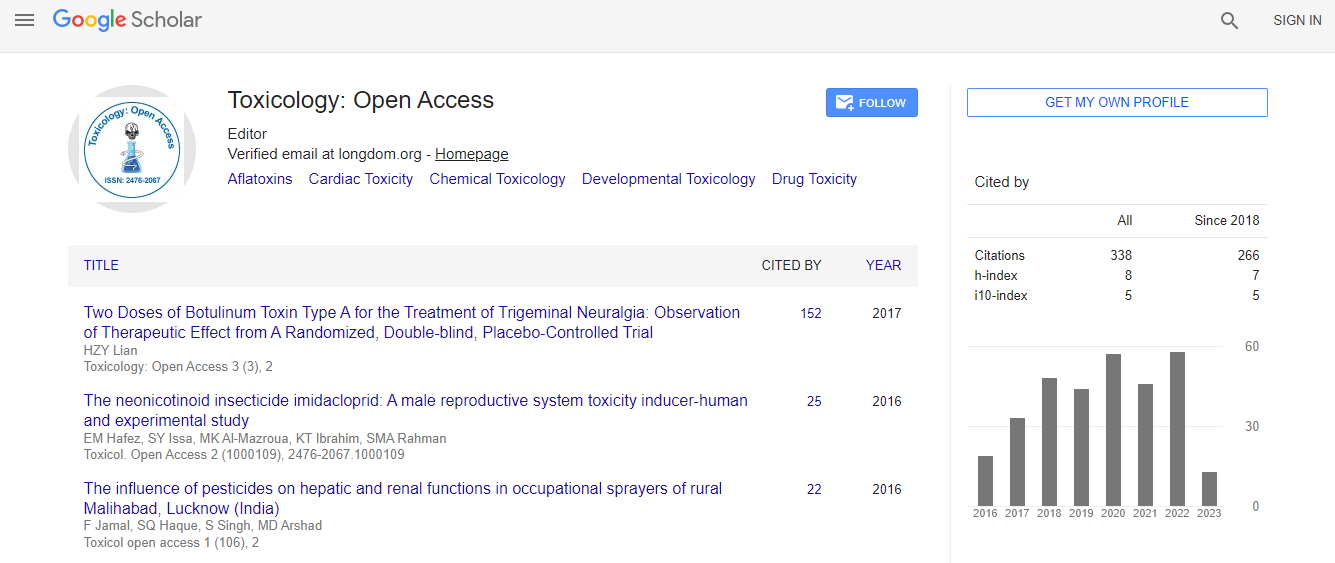Our Group organises 3000+ Global Conferenceseries Events every year across USA, Europe & Asia with support from 1000 more scientific Societies and Publishes 700+ Open Access Journals which contains over 50000 eminent personalities, reputed scientists as editorial board members.
Open Access Journals gaining more Readers and Citations
700 Journals and 15,000,000 Readers Each Journal is getting 25,000+ Readers
Google Scholar citation report
Citations : 336
Toxicology: Open Access received 336 citations as per Google Scholar report
Indexed In
- Google Scholar
- RefSeek
- Hamdard University
- EBSCO A-Z
- Geneva Foundation for Medical Education and Research
- Euro Pub
- ICMJE
Useful Links
Related Subjects
Share This Page
Superoxide mediated apoptosis in cell organelles by photosensitized 1,2:3,4-dibenzanthracene in HaCaT cells at ambient UV-B and natural sunlight
14th World Congress on Toxicology and Pharmacology
Ajeet Kumar Srivastav, Syed Faiz Mujtaba, Jyoti Singh, Deepti Chopra, Divya Dubey, Mohammad Anas, Shikha Agnihotry and Ratan Singh Ray
Indian Institute of Toxicology Research, India Shia PG College, India
ScientificTracks Abstracts: Toxicol Open Access
Abstract
Polycyclic aromatic hydrocarbons (PAHs) are recognized as environmental pollutants because of their intrinsic chemical stability, high resistance and toxic property worldwide. 1,2:3,4 dibenzanthracene (DBA) is a PAH, produced by incomplete combustion of fossil fuels, petroleum discharge. It gets adsorbed on atmospheric particles, mixed into soils, used in tattoo ink and remains for the longest time in the ecosystem. DBA showed strong absorption maxima (�»max) in UV-B (290-320 nm) with low absorption under UV-A (320-400 nm). DBA generates the significant amount of ROS such as O2.-, .OH via type 1 mechanism. In silico study of DBA showed the interaction with aryl hydrocarbon receptor. DBA generates ROS photochemically and intracellularly which was confirmed by DCF/DHE fluorescence intensity while genotoxicity was assessed through comet assay, Hoechst staining, micronuclei formation. The generation of CPDs and 6-4 photoproduct formation, confirm the photogenotoxic potential of DBA. Mitotracker/DAPI, Mitotracker/DHE, Mitotracker/DCF and JC-1 result showed the significant increase in mitochondrial permeability pore complex formation which leads to the release of cytochrome-c in cytosol showed strong evidence for apoptotic cell death by photoirradiation DBA. Cell cycle result showed G2/M phase arrest during cell division. DBA significantly showed over expression of Bax, Parp, Cyt-c, Bak, Caspase 3, Apaf-1, Cathepsin-B, Lamp-1, AhR, tBid, Calpain-7, �³H2Ax, Keap-1, Caspase-12, Caspase-9 and lower expression of Bcl-2, Bid, Hmox and procaspase-3 protein expressions and up-regulation of Apaf-1, Cyt-C, Bax, Caspase-3, Calpain-7, Cathepsin-B, Nrf-2, Keap-1, AhR, Cdk-2, Cdk4, Cycd1, Cycd2, Cycd3, Cdk6, Cyp1a2 and down regulation of Hmox, Bcl-2 genes. The exact mechanism behind DBA phototoxicity was involvement of ROS generation via type-1 mechanism, reduction of an antioxidant level and activation of the apoptotic pathway through mitochondria, nucleus as well as endoplasmic reticulum followed by AhR strongly promotes apoptotic cell death. The study suggests that after the DBA exposure, sunlight/UV-B exposure may avoid preventing from its harmful effects. References 1. Mayati A, Le Ferrec E, Lagadic-Gossmann D and Fardel O (2011) Aryl hydrocarbon receptor-independent up-regulation of intracellular calcium concentration by environmental polycyclic aromatic hydrocarbons in human endothelial HMEC1 cells. Environ. Toxicol.; doi: 10.1002/tox. 20675. 2. Bastianon C, R Zanoni, G Miolo, S Caffieri and E Reddi (2005) Mitochondria and plasma membrane as targets of UV-A induced toxicity of neuroleptic drugs fluphenazine, perphenazine and thioridazine. Int. J. Biochem. Cell Biol.; 37: 901â��908. 3. Kung M H, Yukata K, O'Keefe R J, Zuscik M J (2012) Aryl hydrocarbon receptor-mediated impairment of chondrogenesis and fracture healing by cigarette smoke and benzo(a)pyrene. J Cell Physiol.; 227(3): 1062-70. 4. Rao P S, Kumar S (2015) Polycyclic aromatic hydrocarbons and cytochrome P450 in HIV pathogenesis. Front Microbiol.; 6: 550. 5. Ali D, Verma A, Mujtaba F, Dwivedi A, Hans R K, Ray R S (2011) UVB-induced apoptosis and DNA damaging potential of chrysene via reactive oxygen species in human keratinocytes. Toxicol Lett.; 204(2-3): 199-207.Biography
Ajeet Kumar Srivastav has his research interest in the study of molecular mechanism involved in skin disease, phototoxicity/photogenotoxicity and molecular mechanism involved in skin disease by photosensitive drugs, cosmetics preservatives, hair dyes and PAHs under ambient UV-R/sunlight exposure. Presently, he is working as a Senior Research Fellow at Photobiology Division, Indian Institute of Toxicology Research, Lucknow, India.
Email:srivastav.ajete8@gmail.com

 Spanish
Spanish  Chinese
Chinese  Russian
Russian  German
German  French
French  Japanese
Japanese  Portuguese
Portuguese  Hindi
Hindi 